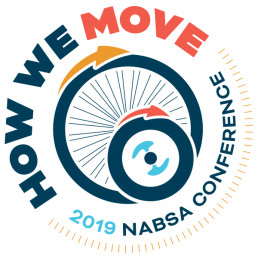
Meet the Keynote: A Q&A with Jay Pitter, MES
This September, NABSA will convene its sixth annual conference in Indianapolis, IN. The NABSA Annual Conference is the leading global venue assembling bikeshare, shared micromobility, and transportation leaders, practitioners, equipment providers. How We Move: Micromobility, Macro Impact will tackle important issues facing the industry, from policy and engagement to innovations in operations.
NABSA is excited to hear from Jay Pitter, MES. Jay is an award-nominated author and placemaker whose practice mitigates growing divides in urban centers. She leads numerous city-building projects including: gender-based mapping, social planning, healing fraught sites, and safe streets and mobility. Transit equity is one of Jay’s passions, and she recently initiated a safe and connected streets engagement following the mass shooting in Toronto, co-led a gender based participatory public transit study, and delivered transit related keynotes at the Canadian Urban Transit Association and the Ontario Bike Summit.
We spoke with Jay about her experience and thoughts on micromobility, how she sees the industry, and what she’s most excited to talk to NABSA about. Here are some of her thoughts.
Your first and only childhood bike has shaped your views on micromobility, can you tell us more about that?
So, before micromobility vehicles like motorized skateboards, unicycles, and velomobiles, we pretty much had bikes and roller skates. For the early part of my childhood, I didn’t have either. However, when I was 10 years-old my beloved dad, a builder in the Caribbean, sent my mom, a relative newcomer to Canada money to buy me a bike. I’ll never forget the joy I felt selecting the brightest red bike in Canadian Tire. My mom opted to purchase a bike I could “grow into” not realizing the safety risks. Sure, my feet dangled too much when I sat on the seat and I didn’t have great balance but this bike, like my shoes and jackets, needed to “last.” My mom cautioned me not to allow my friends to ride my fancy (for us) new bike. But in low-income ‘hoods’ bikes aren’t individual possessions, they’re an invaluable community asset. The moment I took my bike outside, I was swarmed by kids eager to take a spin! We rode out back next to a steep hill because of speeding cars and lack of safe road infrastructure. Around the third day of being gifted with my bike, I lost control and swerved down the hill—no helmet. I was thrown several feet and my bike was destroyed, snaked around a massive tree trunk. Today, as a placemaker working across 15+ North American cities, I’m able to situate this scary experience within a larger systemic city-building context. Using an urban design and social justice lens, it’s clear to see the ways poverty, infrastructure inequity, and culture impact micromobility—this is applicable whether we’re talking about my red bike from back in the day or the sleekest velomobile.
Jay, your research and placemaking practice are focused on urban design and social justice—how do these two concepts apply to bikeshare and shared micromobility?
The bikeshare and micromobility industries have done an excellent job transforming the urban mobility landscape while reducing C02 emissions and providing users with an enjoyable and sometimes more accessible options. However, there is very little acknowledgment of complex socio-political issues, which shape our experiences on roads, and all public spaces for that matter. What’s missing from current conversations is an understanding that people have different experiences when attempting to access and use bikeshare and shared micromobility. While these modes of transportation have undeniable benefits, it’s important to recognize the history of road infrastructure itself. For instance, a recent New York Times article explores how racial segregation is embedded in road infrastructure and responsible for congestion in many cities across the U.S. It isn’t a coincidence that Black Civil Rights movements—within and beyond the U.S.—have largely been centralized around mobility, addressing issues such as equal access public transit, lack of safe street infrastructure, and street-based racial profiling. This is also true of many women’s and anti-poverty movements. Henri Lefebvre, a French philosopher and sociologist said, “cities are places where differences come to know one another.” This is important because the idea of increasing transportation options is ultimately connected to a deeper principle of freedom and mobility equity.
What trends in bikeshare and shared micromobility do you find most promising?
There are a number of great innovations emerging in the bikeshare and micromobility industries but the trend I find most promising is e-bikes. I know this is a controversial position to take because of valid concerns raised about their speeds and lack of consistent regulation. However, I like e-bikes because they lower the barriers for elders, inexperienced cyclists, and persons with disabilities to experiencing the joys and benefits of cycling. But that’s not all. I really like e-bikes because they are igniting a lot of uncomfortable conversations, revealing the need for greater mobility equity and compassion. For example, many cyclists who use traditional bikes refer to e-biking as passive rather than active cycling due to the fact that individuals riding e-bikes follow the motion of the pedals. This has led to the perception that individuals using e-bikes are lazy or uncommitted to the active transportation movement. E-bike users have a wide range of reasons for choosing this mode of transportation—including physical accessibility and increased mobility—and they should all be respected rather than judged and diminished. E-bikes and other forms of electric-powered micromobility vehicles are forcing us to have more nuanced conversations about the ways unhealthy spatial entitlement and power play out on our streets. What we’re seeing is that when faced with sharing space with fellow users, the attitudes of socially progressive transportation advocates can be as biased and inflexible as road infrastructure itself. As bikeshare and micromobility vehicle options increase, tensions increase, forcing us to consider and respect the needs and choices of a diverse range of users. I think this is more exciting than any single bikeshare or micromobility trend.
If you could instantly change something about our transportation network, what would it be?
This question is immense; there are so many things to fix. In addition to recognizing the discrimination embedded in road infrastructure, I’d like to highlight the need to decolonize the transportation network. Roads, paths, and bridges have literally erased all traces of Indigeneity in cities. It’s also important to recognize the erasure of biological and social networks when grappling with the challenge of enhancing transportation networks.
Once these two lesser-explored issues are acknowledged and factored into the way we think about and design transportation networks, the thing I’d like to immediately change is how we define an accessible transportation network. Like affordable housing, the definition of accessible transportation networks is vague. An accessible transportation network is generally defined as the ease of travelling to and arriving at a destination, and transport analysis almost always focuses on the flow of traffic. In the absence of a clear definition of an accessible transportation network, we will continue to see disconnected lanes and pathways, in-fighting among users, and inaction on the part of many decision-makers. I’m looking forward to my upcoming keynote and exchanging ideas with bikeshare and shared micromobility leaders.

